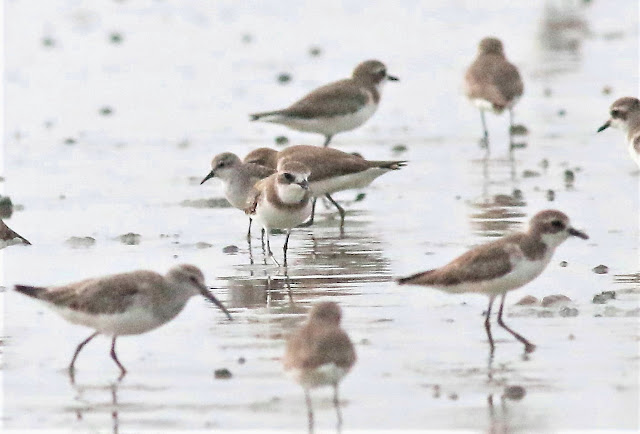Lesser Sand Plover and Greater Sand Plover are one of those charadrius plovers which have different winter, summer and probably immature plumages to feast your eyes. Lesser Sand Plover has quite an extensive range (Birdlife International data) and over here their numbers can be six or seven times more than Greater Sand Plover. Currently there are two races of Lesser Sand Plovers. They are i) C.m atrifrons or Spot-fronted Sand Plover and ii) C.m mongolus or Black-fronted Sand Plover (Suara Enggang, Vol. 20. No. 1 (2012). The one which mostly occur here according to most field guides is C.m atrifrons or more commonly known as Tibetan Plover.
Their stunning head patterns and breast bands during summer/breeding season have kept many waders enthusiast as well as bird photographers returning to the intertidal zones. Here are some of them in their winter plumage. Photos were taken recently (Jan to Feb 2020) from the inter-tidal mudflats around Kuala Muda and the North Central Selangor coastline. Due to their winter plumage, most of the photos here appear like monochrome which makes it difficult to differentiate the various races within this species. Aside from that you can however able to see their different sizes and winter plumages from the various photos depicted here.
LESSER SAND PLOVER
A small group of Lesser Sand Plovers enjoying their early morning basking on the mudflats.
Lesser Sand Plover in flight
Their upper wings plumage can vary according to age, weather etc.
You may have noticed the different breast bands on the above Lesser Sand Plovers
From my observations, most of them would have a small patch of whitish foreheads when they first fly in from their northern breeding grounds and this whitish foreheads will spread wider while they are wintering here. More observations will be required to confirm this statement.
They would constantly look upwards if they spot any raptors - usually its the Brahminy Kites.
Lesser Sand Plover with a Kentish Flover (third from right)
This one has an upturned 'eye-brow'.
GREATER SAND PLOVER
Here are some Greater Sand Plovers among the many Lesser Sand Plovers
LESSER AND GREATER SAND PLOVER
Here are a few charts to depict the general distribution of the Lesser Sand Plover and Greater Sand Plover in Peninsular Malaysia. These charts are by no means scientific but they do provide some baseline data on the movements of the plovers around this region. The data at Kuala Muda coastline were taken from Kampung Permatang, Keriang (5.5639, 100.3600) up to Kuala Muda coast (5.6028, 100.3489) while the info for Teluk Air Tawar-Bagan Belat (TAT-Bagan Belat) site were collated from Bagan Belat up to Kampung Batu 20. All info were extracted from entries of birders in ebird Malaysia.
CHART 1
Chart 1 shows the number of Lesser and Greater at Kuala Muda and TAT-Bagan Belat. Both Lesser and Greater Sand Plover numbers appear to be on downward trend from 2016 onwards although Lesser Sand Plover numbers show a steep upward trajectory from 2017 to 2019. The Greater Sand Plover numbers however appear to show a significant decline in 2019 (211) as compared to the numbers in 2015 (1130) i.e a substantial decreased of 81%.
CHART 2
CHART 3
CHART 4
CHART 5
CHART6
Chart 2 shows the comparison of the number of Lesser Sand Plover at Kuala Muda Coast and TAT-Bagan Belat region. As you can see the numbers at TAT-Bagan Belat region begin to declined from year 2016 onwards and remain plateau thereafter. Meanwhile on the other hand the numbers of Lesser Sand Plovers at Kuala Muda coast has increased from year 2017 onwards. The reason for this can be attributed to the land reclamation works (to cope with the rising sea level) at TAT-Bagan Belat region which begin in late 2106 and continued through out 2017 and 2018. So it is most likely that the Lesser Sand Plover population in TAT-Bagan Belat has 'migrated' to Kuala Muda coast during that period.
CHART 3
Similarly the number of Greater Sand Plover started to plunged at both Kuala Muda and TAT-Bagan Belat regions from 2016 to 2017. Their numbers eventually increased in 2017 at Kuala Muda coast while the numbers at TAT-Bagan Belat continue to decline.
Chart 4 shows that while the number of Lesser Sand Plover at Kuala Muda has risen from 2017 onwards but the numbers at Mersing and TAT-Bagan Belat have declined from 2018 onwards.
CHART 5
As expected, the coastline of Kapar has supported the most Lesser Sand Plovers in the western side of Peninsular Malaysia (37%), followed by Kuala Muda (31%) and TAT-Bagan Belat (16%).
CHART6
For Greater Sand Plovers, Mersing and TAT-Bagan Belat area seems to share the same proportions at 15% and 12% respectively while Kapar (62%) has been the most popular roosting site for both Lesser and Greater Sand Plovers alike.
HAPPY WADER WATCHING !
A PICTURE PAINTS A THOUSAND WORDS
A CHART SHOWS A THOUSAND MEANINGS !






































No comments:
Post a Comment